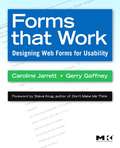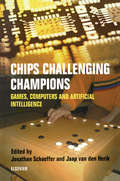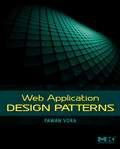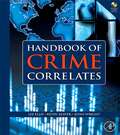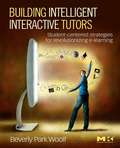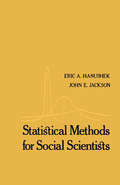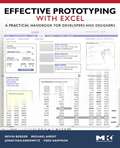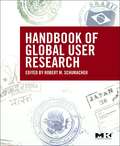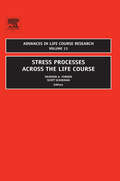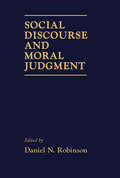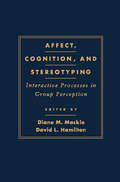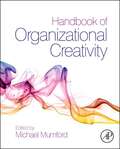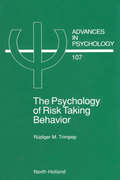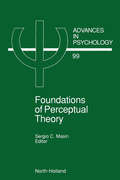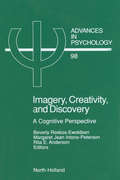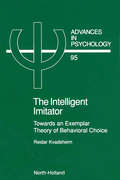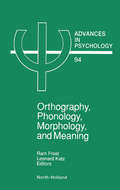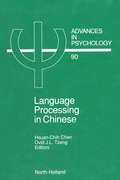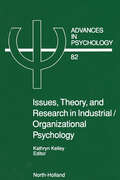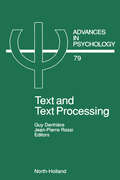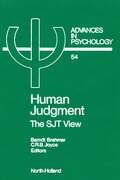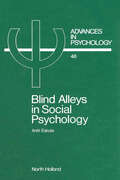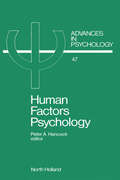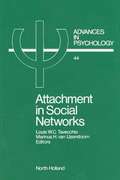- Table View
- List View
Forms that Work: Designing Web Forms for Usability (Interactive Technologies)
by Caroline Jarrett Gerry GaffneyForms that Work: Designing Web Forms for Usability clearly explains exactly how to design great forms for the web. The book provides proven and practical advice that will help you avoid pitfalls, and produce forms that are aesthetically pleasing, efficient and cost-effective. It features invaluable design methods, tips, and tricks to help ensure accurate data and satisfied customers. It includes dozens of examples - from nitty-gritty details (label alignment, mandatory fields) to visual designs (creating good grids, use of color). This book isn’t just about colons and choosing the right widgets. It’s about the whole process of making good forms, which has a lot more to do with making sure you’re asking the right questions in a way that your users can answer than it does with whether you use a drop-down list or radio buttons. In an easy-to-read format with lots of examples, the authors present their three-layer model - relationship, conversation, appearance. You need all three for a successful form - a form that looks good, flows well, asks the right questions in the right way, and, most important of all, gets people to fill it out. Liberally illustrated with full-color examples, this book guides readers on how to define requirements, how to write questions that users will understand and want to answer, and how to deal with instructions, progress indicators and errors. This book is essential reading for HCI professionals, web designers, software developers, user interface designers, HCI academics and students, market research professionals, and financial professionals.*Provides proven and practical advice that will help you avoid pitfalls, and produce forms that are aesthetically pleasing, efficient and cost-effective. *Features invaluable design methods, tips, and tricks to help ensure accurate data and satisfied customers. *Includes dozens of examples -- from nitty-gritty details (label alignment, mandatory fields) to visual designs (creating good grids, use of color).*Foreword by Steve Krug, author of the best selling Don't Make Me Think!
Chips Challenging Champions: Games, Computers and Artificial Intelligence
by J. Schaeffer H.J. van den HerikOne of the earliest dreams of the fledgling field of artificial intelligence (AI) was to build computer programs that could play games as well as or better than the best human players. Despite early optimism in the field, the challenge proved to be surprisingly difficult. However, the 1990s saw amazing progress. Computers are now better than humans in checkers, Othello and Scrabble; are at least as good as the best humans in backgammon and chess; and are rapidly improving at hex, go, poker, and shogi. This book documents the progress made in computers playing games and puzzles. The book is the definitive source for material of high-performance game-playing programs.
Web Application Design Patterns (Interactive Technologies)
by Pawan VoraEver notice that—in spite of their pervasiveness—designing web applications is still challenging? While their benefits motivate their creation, there are no well-established guidelines for design. This often results in inconsistent behaviors and appearances, even among web applications created by the same company. Design patterns for web applications, similar in concept to those for web sites and software design, offer an effective solution. In Web Application Design Patterns, Pawan Vora documents design patterns for web applications by not only identifying design solutions for user interaction problems, but also by examining the rationale for their effectiveness, and by presenting how they should be applied.Design interfaces faster, with a better rationale for the solutions you choose.Learn from over more than 100 patterns, with extensive annotation on use and extension.Take a short-cut into understanding the industry with more than 500 full-color screenshots.
Handbook of Crime Correlates
by John Wright Lee Ellis Kevin M. BeaverOver the past two centuries, many aspects of criminal behavior have been investigated. Finding this information and making sense of it all is difficult when many studies would appear to offer contradictory findings. The Handbook of Crime Correlates collects in one source the summary analysis of crime research worldwide. It provides over 400 tables that divide crime research into nine broad categories: Pervasiveness and intra-offending relationships Demographic factors Ecological and macroeconomic factors Family and peer factors Institutional factors Behavioral and personality factors Cognitive factors Biological factors Crime victimization and fear of crime Within these broad categories, tables identify regions of the world and how separate variables are or are not positively or negatively associated with criminal behavior. Criminal behavior is broken down into separate offending categories of violent crime, property crime, drug offenses, sex offenses, delinquency, general and adult offenses, and recidivism. Accompanying each table is a description of what each table indicates in terms of the positive or negative association of specific variables with specific types of crime by region. This book should serve as a valuable resource for criminal justice personnel and academics in the social and life sciences interested in criminal behavior.
Building Intelligent Interactive Tutors: Student-centered Strategies for Revolutionizing E-learning
by Beverly Park WoolfBuilding Intelligent Interactive Tutors discusses educational systems that assess a student's knowledge and are adaptive to a student's learning needs. The impact of computers has not been generally felt in education due to lack of hardware, teacher training, and sophisticated software. and because current instructional software is neither truly responsive to student needs nor flexible enough to emulate teaching. Dr. Woolf taps into 20 years of research on intelligent tutors to bring designers and developers a broad range of issues and methods that produce the best intelligent learning environments possible, whether for classroom or life-long learning. The book describes multidisciplinary approaches to using computers for teaching, reports on research, development, and real-world experiences, and discusses intelligent tutors, web-based learning systems, adaptive learning systems, intelligent agents and intelligent multimedia. It is recommended for professionals, graduate students, and others in computer science and educational technology who are developing online tutoring systems to support e-learning, and who want to build intelligence into the system.Combines both theory and practice to offer most in-depth and up-to-date treatment of intelligent tutoring systems availablePresents powerful drivers of virtual teaching systems, including cognitive science, artificial intelligence, and the InternetFeatures algorithmic material that enables programmers and researchers to design building components and intelligent systems
Statistical Methods for Social Scientists
by Eric A Hanushek John E. JacksonThe aspects of this text which we believe are novel, at least in degree, include: an effort to motivate different sections with practical examples and an empirical orientation; an effort to intersperse several easily motivated examples throughout the book and to maintain some continuity in these examples; and the extensive use of Monte Carlo simulations to demonstrate particular aspects of the problems and estimators being considered. In terms of material being presented, the unique aspects include the first chapter which attempts to address the use of empirical methods in the social sciences, the seventh chapter which considers models with discrete dependent variables and unobserved variables. Clearly these last two topics in particular are quite advanced--more advanced than material that is currently available on the subject. These last two topics are also currently experiencing rapid development and are not adequately described in most other texts.
Effective Prototyping with Excel: A Practical Handbook for Developers and Designers (Interactive Technologies)
by Jonathan Arnowitz Michael Arent Nevin Berger Fred SampsonAlthough recognized as a key to the design process, prototyping often falls victim to budget cuts, deadlines, or lack of access to sophisticated tools. This can lead to sloppy and ineffective prototypes or the abandonment of them altogether. Rather than lose this important step, people are turning to Microsoft Excel® to create effective, simple, and inexpensive prototypes. Conveniently, the software is available to nearly everyone, and most are proficient in its basic functionality. Effective Prototyping with Excel offers how-to guidance on how everyone can use basic Excel skills to create prototypes – ranging from narrative wire frames to hi-fidelity prototypes. A wide array of software design problems and business demands are solved via practical step-by-step examples and illustrations.Step-by-step guide to prototyping with a simple and affordable tool nearly everyone already has on their desktopQuickly and easily allows web and software designers to explore usability, design alternatives, and test theories prior to starting productionPerfect companion to Effective Prototyping for Software Makers – with the same author team and full-color treatment, useful case studies, and hands-on exercises
The Handbook of Global User Research
by Robert SchumacherUser research is global – yet despite its pervasiveness, practitioners are not all well equipped to work globally. What may have worked in Nigeria may not be accepted in Russia, may be done differently in Brazil, may partly work in China, and may completely fail in Kuwait. And what often goes less noticed, but can be equally vexing are technical, logistical and planning issues such as hiring qualified translators, payment procedures, travel issues, setting up facilities and finding test participants. The Handbook of Global User Research is the first book to focus on global user research. The book collects insight from UX professionals from nine countries and, following a typical project timeline, presents practical insights into the preparation, fieldwork, analysis and reporting, and overall project management for global user research projects. Any user experience professional that works on global projects -- including those new to the field, UX veterans who need information on this expanding aspect of user research, and students -- will need this book to do their job effectively.*Presents the definitive collection of hard won lessons from user research professionals around the world *Includes real-world examples of global user research challenges and provides approaches to these issues *Contains anecdotes and hard-won from the field that illustrate actionable tactics for practitioners
Stress Processes across the Life Course (ISSN #Volume 13)
by Heather A. Turner Scott SchiemanStress researchers have become increasing aware of the ways in which structural and psychosocial variations in the life course shape exposure and vulnerability to social stress. This volume of Advances in Life Course Research explores, theoretically and empirically, stress processes both within and across specific life stages. Chapters within this volume incorporate several areas of research, including:• How physical and mental health trajectories are shaped by life course variations in stressors and resources• Stress associated with social role transitions and the significance of different role trajectories for stress exposure and outcomes • Life course variations in the quality and content of institutional contexts (such as school, work and family) and their significance for stress processes• Differences in types, levels, and effects of different stress-moderating resources within and across life course stages• Ways in which race, gender, and social class influence or condition stress processes over the life course• The relevance of “linked lives" within families and across generations for stress exposure and vulnerability• Historical variations in stress-related conditions and cohort differences in stress experiences• Methodological and theoretical advances in studying stress processes across the life course
Social Discourse and Moral Judgement
by Daniel N. RobinsonThis edited work presents a unique and authoritative look at morality - its development within the individual, its evolution within society, and its place within the law. The contributors represent some of the foremost authorities in these fields, and the book represents a collection of essays presented at a symposium on social constructivism and morality.
Affect, Cognition and Stereotyping: Interactive Processes in Group Perception
by Diane M. Mackie David L. HamiltonThis volume presents a collection of chapters exploring the interface of cognitive and affective processes in stereotyping. Stereotypes and prejudice have long been topics of interest in social psychology, but early literature and research in this area focused on affect alone, while later studies focused primarily on cognitive factors associated with information processing strategies. This volume integrates the roles of both affect and cognition with regard to the formation, representation, and modification of stereotypes and the implications of these processes for the escalation or amelioration of intergroup tensions. Reviewed Development, maintenance, and change of stereotypes and prejudice Interaction of affective and cognitive processes as antecendents of stereotyping and prejudice Affect and cognitive consequences of group categorization, preception, and interaction The interaction of cognitive and affective processes in social perception Award Winning Chapter "The Esses et al", was the 1992 winner of the Otto Klineberg award given by the Society for the Psychological Study of Social Issues, which cited the chapter as having offered, "a substantial advance in our understanding of basic psychological processes, underlying racism, stereotyping, and prejudice."
Handbook of Organizational Creativity
by Michael D. MumfordHandbook of Organizational Creativity is designed to explain creativity and innovation in organizations. This handbook contains 28 chapters dedicated to particularly complex phenomena, all written by leading experts in the field of organizational creativity. The format of the book follows the multi-level structure of creativity in organizations where creativity takes place at the individual level, the group level, and the organizational level. Beyond just theoretical frameworks, applications and interventions are also emphasized. This topic will be of particular interest to managers of creative personnel, and managers that see the potential benefit of creativity to their organizations.Information is presented in a manner such that students, researchers, and managers alike should have much to gain from the present handbookVariables such as idea generation, affect, personality, expertise, teams, leadership, and planning, among many others, are discussedSpecific practical interventions are discussed that involve training, development, rewards, and organizational developmentProvides a summary of the field’s history, the current state of the field, as well as viable directions for future research
The Psychology of Risk Taking Behavior (ISSN #Volume 107)
by R.M. TrimpopThis book aims to help the reader to understand what motivates people to engage in risk taking behavior, such as participating in traffic, sports, financial investments, or courtship. The consequences of risk taking may be positive, or result in accidents and injuries, especially in traffic. The wealth of studies and theories (about 1000 references) is used to offer a cohesive, holistic view of risk motivation. The risk motivation theory is a dynamic state-trait model incorporating physiological, emotional and cognitive components of risk perception, processing and planning. If a deficit exists between desired and perceived risk, risk compensation behavior results. A feedback loop provides new information for the next perception-motivation-behavior process. Assumptions were tested and support was found with 120 subjects in a longitudinal study. The concepts and findings are discussed in relation to psychological theories and their meaning for our daily lives.
Foundations of Perceptual Theory (ISSN #Volume 99)
by S. C. MasinHistorical analysis reveals that perceptual theories and models are doomed to relatively short lives. The most popular contemporary theories in perceptual science do not have as wide an acceptance among researchers as do some of those in other sciences. To understand these difficulties, the authors of the present volume explore the conceptual and philosophical foundations of perceptual science. Based on logical analyses of various problems, theories, and models, they offer a number of reasons for the current weakness of perceptual explanations. New theoretical approaches are also proposed. At the end of each chapter, dicussants contribute to the conclusions by critically examining the authors' ideas and analyses.
Imagery, Creativity, and Discovery: A Cognitive Perspective (ISSN #Volume 98)
by B. Roskos-Ewoldsen M. J. Intons-Peterson R. E. AndersonWhat factors affect creativity and the generation of creative images? What factors affect the ability to reinterpret those images? Research described in this book indicates that expectations constrain both of these attributes of creativity. Characteristics of the imagined pattern, such as cohesiveness or its psychological goodness, also affect image generation and reinterpretation. Other evidence indicates that images can be combined mentally to yield new, manipulable composites. Cognitive models encompass the research and extend it to fields as diverse as architecture, music, and problem solving.
The Intelligent Imitator: Towards an Exemplar Theory of Behavioral Choice (ISSN #Volume 95)
by R. KvadsheimThis monograph presents a novel conceptual framework for the study of human social behavior with potentially far-reaching implications. Owing to the role it accords to stored memory representations of observed occurrences (examples) of actions, the proposed framework is referred to as the Exemplar Choice Theory, or ECT. The theory links perception and action and combines an expectancy-value perspective on choice behavior, with features of recent exemplar-based approaches to the study of human information processing. It addresses the influence of social models, as well as the impact of past action consequences and differs from extant theories of instrumental learning. The volume focuses on two extreme classes of conditions defined in terms of the actor's limited access to information and discusses available evidence from many areas of psychology. Its structure is as follows: the introductory chapter locates the proposed theory within a historical context; this is followed by an overview of the main structure of the conceptual framework; subsequently, general propositions are presented and discussed in detail; later, empirical implications are derived for certain extreme classes of choice conditions and considered in the light of empirical evidence. It is hoped the publication will inspire students and researchers of psychology, biology, zoology and of many social sciences, including sociology, anthropology, decision research, marketing, economics, cognitive science and mass media studies to undertake further research and to reconsider existing data and frameworks.
Orthography, Phonology, Morphology and Meaning (ISSN #Volume 94)
by R. Frost Marian KatzThe area of research on printed word recognition has been one of the most active in the field of experimental psychology for well over a decade. However, notwithstanding the energetic research effort and despite the fact that there are many points of consensus, major controversies still exist.This volume is particularly concerned with the putative relationship between language and reading. It explores the ways by which orthography, phonology, morphology and meaning are interrelated in the reading process. Included are theoretical discussions as well as reviews of experimental evidence by leading researchers in the area of experimental reading studies. The book takes as its primary issue the question of the degree to which basic processes in reading reflect the structural characteristics of language such as phonology and morphology. It discusses how those characteristics can shape a language's orthography and affect the process of reading from word recognition to comprehension.Contributed by specialists, the broad-ranging mix of articles and papers not only gives a picture of current theory and data but a view of the directions in which this research area is vigorously moving.
Language Processing in Chinese (ISSN #Volume 90)
by Hsuan-Chih Chen Ovid J. L. TzengThe aim of this book is to integrate the most recent research in the cognitive aspects of the Chinese language into a single academic reference for those interested in language processing and related fields. Chinese is perhaps the most widely used language in the world. In addition to its popularity, many specific features make it unique in relation to many Indo-European languages. Chinese words generally do not have inflections indicating grammatical attributes such as number, gender and case for nouns, or tense and aspect for verbs. Chinese words have no inherently marked lexical categories. Unlike the alphabetic symbols common to Indo-European languages, the Chinese writing system is logographic in nature. Chinese script/speech relationship is highly opaque, with the Chinese characters representing lexical morphemes in contrast to alphabetic symbols which represent phonemes. This volume presents research findings indispensable to the general understanding of human language processing about how people process the Chinese language.
Issues, Theory, and Research in Industrial/Organizational Psychology (ISSN #Volume 82)
by K. KelleyIndustrial/Organizational psychologists are a rather diverse group of people with a common interest in applying psychology to work settings. This is the conclusion reached by George Alliger in the opening chapter of this volume, setting the tone for the rest of the book, which attempts to expand our view of what can be considered as I/O psychology.The authors of the individual chapters are from a variety of backgrounds, not all of them directly associated with I/O psychology, and they discuss topics such as managerial success andtraining, as well as topics much more on the edge of I/O such as team-building and organizational theory. Thus, this volume makes an important statement about the potential diversity of our field. At the same time, it will help move ustowards that diversity by providing insights and information in areas that should be, and are becoming part of the realm of I/O psychology. These insights into non-traditional topics, as well as particularly interesting approaches to more traditional areas, make this volume worthwhile and useful to almost anyone concerned with I/O psychology.
Text and Text Processing (ISSN #Volume 79)
by G. Denhiere J. P. RossiThe book presents the state-of-the-art in major aspects of text analysis and cognitive text processing by some of the most well-known European and American researchers in the field of text-linguistics and cognitive psychology. Comprehensive views and new perspectives are proposed in the following topics: cognitive and metacognitive aspects of text processing, structures and processes involved in the construction of multi-level semantic representations in relation with text and reader characteristics, achievement of local and global coherence of meaning during reading and comprehension, assessment of knowledge, knowledge acquisition of concepts and complex systems by text, and cognitive and metacognitive aspects of text production.
Targets of Violence and Aggression (ISSN #Volume 76)
by R. BaenningerThe chapters in this volume have been written by authors whose research work emphasizes the aggression-eliciting characteristics of people and other animals, the traits that make them targets of aggressive behavior. The clear focus of the book is on aggression by humans, although some of the authors may refer to data from other species. Chapters include aggression and violence towards other species, sexual minorities, psychiatric workers, school children, athletes, women, and drivers on highways. There are additional targets of aggressive behavior which have not been included because they are not emphasised in the research literature of psychology. Since the major concern of psychological science is with the behavior of individuals rather than groups, topics such as racial violence, warfare, and political violence have been specifically excluded.
Human Judgment: The SJT View (ISSN #Volume 54)
by B. Brehmer C. R. B. JoyceThere are four basic goals for research in SJT (Social Judgment Theory): - to analyze judgment tasks and judgmental processes; - to analyze the relations between judgmental systems (i.e. to analyze agreement and its structure), and between tasks and judgmental systems (i.e. to analyze achievement and its structure; - to understand how relations between judgmental systems and between judgmental systems and tasks come to be whatever they are (i.e. to understand processes of communication and learning and their effects upon achievement and agreement); - to find means of improving the relation between judgmental systems (improving agreement) and between judgmental systems and tasks (improving achievement).
Blind Alleys in Social Psychology: A Search for Ways Out (ISSN #Volume 48)
by A. Eskola A. Kihlström D. Kivinen K. Weckroth O.-H. YlijokiReal advances are not made in blind alleys (or culs-de-sac). In Social Psychology, as in every branch of science, the paths which appear to offer progress do not always result in theoretical elegance. Certain basic problems persistently defy final solution.This volume surveys the foundations and methods of Social Psychology with the aim of identifying ways out of the research maze. It examines the history and traditions of the field, looks at methodology and conceptual schemes, and discusses the actual research methods used.
Human Factors Psychology (ISSN #Volume 47)
by P. A. HancockThis book is a collection of contemporary applications of psychological insights into practical human factors issues. The topics are arranged largely according to an information processing/energetic approach to human behavior. Consideration is also given to human-computer interaction and organizational design.
Attachment in Social Networks: Contributions to the Bowlby-Ainsworth Attachment Theory (ISSN #Volume 44)
by L W C Tavecchio M. H. Van IJzendoornThe main objective of the research presented in this book is to broaden the scope of attachment theory by stressing the importance of a social network approach to the study of attachment.This approach forms the integrating theme of this volume, as is testified by various studies of attachment as it develops in an "extended" rearing context over and beyond the limits of the traditional mother-child dyad. In this connection attention is paid to the importance of sibling relationships, attachment relationships with professional caregivers, the role of the father in caring and rearing young children, and the (short-term and long-term) effects on attachment quality of maternal employment in infancy. Also, the cross-cultural validity of Ainsworth's Strange Situation is discussed, with reference to the USA, Sweden, Israel, Japan, The Netherlands, etc. In adopting a social network approach, the attachment theory proves to be a particularly useful instrument for reflecting on the consequence of social change (maternal employment, symmetrical families, socialisation of childrearing) for child development.
